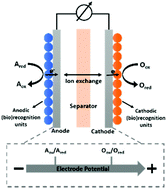当前位置:
X-MOL 学术
›
Chem. Soc. Rev.
›
论文详情
Our official English website, www.x-mol.net, welcomes your
feedback! (Note: you will need to create a separate account there.)
Self-powered electrochemical systems as neurochemical sensors: toward self-triggered in vivo analysis of brain chemistry
Chemical Society Reviews ( IF 40.4 ) Pub Date : 2017-04-18 00:00:00 , DOI: 10.1039/c7cs00148g Fei Wu 1, 2, 3, 4, 5 , Ping Yu 1, 2, 3, 4, 5 , Lanqun Mao 1, 2, 3, 4, 5
Chemical Society Reviews ( IF 40.4 ) Pub Date : 2017-04-18 00:00:00 , DOI: 10.1039/c7cs00148g Fei Wu 1, 2, 3, 4, 5 , Ping Yu 1, 2, 3, 4, 5 , Lanqun Mao 1, 2, 3, 4, 5
Affiliation

|
Real-time in vivo analysis of neurochemical dynamics has great physiological and pathological implications for a full understanding of the brain. Self-powered electrochemical systems (SPESs) built on galvanic cell configurations bear the advantages of easy miniaturization for implantation and no interference to electric activities of neurons over traditional externally-powered electrochemical sensors for self-triggered in vivo analysis. However, this is still a new concept for in vivo neurochemical sensing with few implanted examples reported so far. This tutorial review summarizes the development of SPESs toward implantable applications from both principal and practical perspectives, ultimately aimed at providing a guide map to the future design of neurochemical sensors for in vivo analysis of brain chemistry.
中文翻译:

自供电电化学系统作为神经化学传感器:对脑化学物质的自触发体内分析
实时体内神经化学动力学分析对全面了解大脑具有重要的生理和病理意义。建立在原电池结构上的自供电电化学系统(SPES)具有易于植入的优点,并且与传统的用于自触发体内分析的外部供电电化学传感器相比,不易干扰神经元的电活动。但是,这仍然是体内新概念迄今为止,几乎没有报道过神经化学感应的例子。本教程的回顾从原理和实践的角度总结了SPES在植入式应用方面的发展,最终旨在为将来进行脑化学体内分析的神经化学传感器的设计提供指导图。
更新日期:2017-05-04
中文翻译:

自供电电化学系统作为神经化学传感器:对脑化学物质的自触发体内分析
实时体内神经化学动力学分析对全面了解大脑具有重要的生理和病理意义。建立在原电池结构上的自供电电化学系统(SPES)具有易于植入的优点,并且与传统的用于自触发体内分析的外部供电电化学传感器相比,不易干扰神经元的电活动。但是,这仍然是体内新概念迄今为止,几乎没有报道过神经化学感应的例子。本教程的回顾从原理和实践的角度总结了SPES在植入式应用方面的发展,最终旨在为将来进行脑化学体内分析的神经化学传感器的设计提供指导图。











































 京公网安备 11010802027423号
京公网安备 11010802027423号